Jump To:
Researching Pregnancy
Pregnancy Lifestyle
Where to Deliver
Labor and Delivery
Our Parenting Choices
What We’ve Learned
Further Reading
One of the first things Vicky and I established when we first became romantically involved is that we both wanted to have children. We share a deep love of science and the natural world and wanted to share our sense of wonder with children of our own. At the same time, in our sharing we were hoping to experience the world vicariously through fresh eyes, reliving the thrill of learning and discovery.
When the pregnancy test finally came up positive, we were launched into a whole new realm of learning: reading up on diet, lifestyle, and fetal development. We were also put into an unanticipated tour of various types and standards of prenatal care. This post covers what we learned and what we are continuing to learn about pregnancy and childcare.
Researching Pregnancy
Medical Science has doubled of our lifespans over the last 200 years, but it has also made some horrible mistakes when it comes to childbirth. When we asked Vicky’s grandmother about her birthing experiences, she described the days when doctors would administer women in labor the Twilight Sleep drug, which prevented the woman from remembering the act of giving birth, but would also make her lose all self-control, so that she had to be strapped to the hospital bed and wear a helmet so she could wail and thrash. When we asked Vicky’s mother about breast feeding, she told us about how the doctors discouraged the practice, saying it was unsanitary and had less nutritional value than formula. Pre-1950s psychology took the position that showing affection for children was unhealthy and discouraged kissing or otherwise cuddling babies lest they have serious issues later in life. These were unfortunate ideas that manifested lifetimes worth of problems for children born during the times they were popular, but science is a self-correcting algorithm, so I made a point of doing some heavy reading in hopes of learning the latest, most refined understanding of what’s best for pregnancy, labor, and child-rearing.
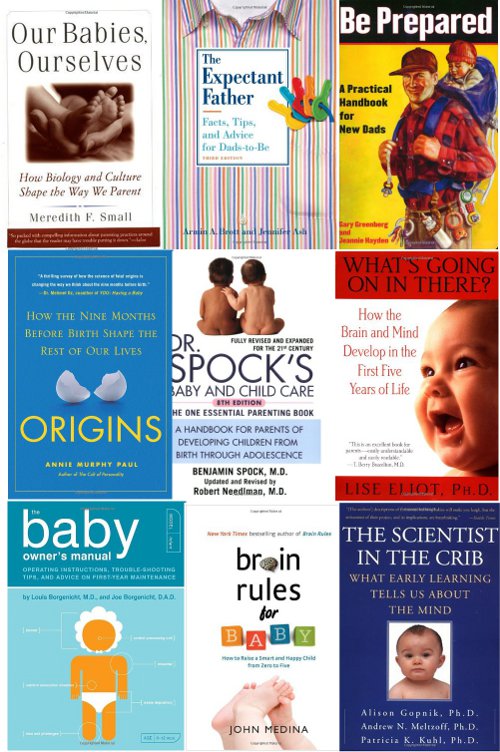
Pregnancy and Baby Care Books
Anne Marie Paul’s Origins: How the Nine Months Before Birth Shape the Rest of Our Lives made for a good overview of how life in the womb is affected by the pregnant mother’s environment. It explains, in down to Earth terms, what the mother should eat, what she should avoid, and what lifestyle choices, such as exercise and stress, she should engage and avoid for the health of her developing baby. Humans are a highly-adaptable species, and Paul argues that the fetus is taking in information about the environment into which it will be born so that its brain and body will be customized to best survive in that world.
Meredith Small’s Our Babies, Ourselves: How Biology and Culture Shape the Way We Parent is an important part of the attachment parenting philosophy, which stresses being keenly sensitive to the child’s needs to form a strong emotional bond with them. I appreciated the book’s evolutionary perspective on the subject, advocating co-sleeping and breastfeeding because our ancestors adhered to these practices. The book looks at various cultures and their differing parenting styles to help come to its conclusions. This foundation in anthropology and evolutionary psychology really appealed to me.
Gopnik, Meltzoff, and Kuhl’s The Scientist in the Crib: What Early Learning Tells Us About the Mind was a fascinating peek into an infant’s cognitive development. I loved the premise that babies are like scientists, testing hypotheses and adjusting their worldview according to the results. The book has an explanation of the “Terrible Twos” that impressed me: infants at that time are learning that your perspective is different from their perspective and they are having a hard time adjusting their understanding of the world accordingly. The book lays out its ideas exquisitely, bringing all the ideas together into a summary at the end that highly intellectually satisfying.
Lise Eliot’s What’s Going on in There? : How the Brain and Mind Develop in the First Five Years of Life is an exhaustive overview of every single aspect of the fetus and infant’s development and is also my favorite of all the books I read. The book covers the physiological development all five senses and several other senses that I didn’t even know about. It provides exercises for stimulating these senses so that the child’s brain wires up properly to best take advantage of them. The book can also be a bit scary as it goes over all the things that can go wrong in a child’s development, which set me on edge, but they are important things to be aware of so you can recognize them and get your child the help they need should they manifest.
John Medina’s Brain Rules for Baby: How to Raise a Smart and Happy Child from Zero to Five felt like the Cliff Notes version of Lise Eliot’s book, and that’s a good thing. It’s down to Earth and gets right to what you want to know about turning your child into a supersmart superhuman. I really appreciated some of the worldview adjustments Medina gives, such as to avoid praising your child for being smart, instead, praise them for working hard. Smart is out of our control, but failing a test because you didn’t work hard is something you can overcome.
Depending on your personality, there were a series of “easy reading” books that were less scientific and more about commiseration and practically dealing with parenting and childbirth. For nerds I recommend the Baby Owner’s Manual, found on Think Geek, for its clinically humorous way of covering baby care. For regular guys I suggest the The Expectant Father: Facts, Tips, and Advice for Dads-to-Be, which was pretty in-depth and covered a whole lot of territory focused on the male’s role in things. While men’s men should go with Be Prepared: A Practical Handbook for New Dads, which actually works on a whole lot of levels, is the funniest of the books I picked up, and has great “circuit training” advice for exercising your baby.
Dr. Benjamin Spock’s Dr. Spock’s Baby and Child Care: 8th Edition was the “Manual” that everyone took when they kidnapped the baby in the film “Raising Arizona.” It’s criticized for using inductive reasoning rather than evidence-based medicine, and I found some glaring errors in an early edition of the book, like advising parents to put their baby to sleep face down, which we now know puts them at a higher risk of Sudden Infant Death Syndrom (SIDS); however, later editions of the book correct these errors and overall the book works as a great big encyclopedia of baby care advice. At the same time, while the book is on my shelf, I’m still more likely to hit a search engine to find out why there’s a white fungus growing on my baby’s tongue (It’s called thrush and it’s perfectly normal).
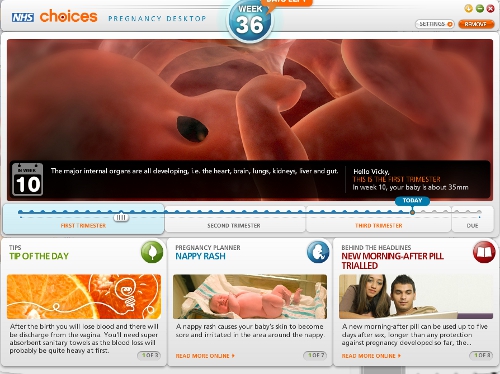
NHS Pregnancy Desktop
Beyond books, I highly recommend parents check out the UK National Health Services’ (NHS) – Pregnancy Desktop application, especially for expectant dads. One problem I had early on during Vicky’s pregnancy was that she was completely on top of what needed to be done at what week in the process, so that I felt like I was just following along under her guidance. The Pregnancy Desktop application sits on your desktop, opening on startup, and serves as a constant reminder of how many weeks and days you have left until your due date, what’s going on with the baby, and what you should be doing to prepare. Some of the information it provides is UK-specific, but there is also a bounty of good information for mothers in any country. Again, highly recommended.
By far, the most beneficial preparation we made was in attending Bradley Method Classes to learn about Husband-Coached Natural Childbirth based on Richard Bradley’s Husband-Coached Childbirth: The Bradley Method of Natural Childbirth, where the husband takes a strong supporting role in the wife’s labor, monitoring contractions, tending to her needs and making sure she’s comfortable, and providing emotional support to help her achieve an unmedicated delivery. In addition to practice exercises to prepare for labor, the classes are also fantastic for the way they educate students on the mechanics and physiological aspects of labor. We learned about various medical interventions the doctor’s might use, pregnancy complications we may experience, and lots of information about what’s going on with the baby and mother’s bodies during labor. One factoid I found very interesting had to do with the health effects of cutting the umbilical cord after delivery, which doctors rush to do, but is probably best to hold off on in order to allow the placenta to pump all of its blood into the baby. The classes are important because the books and software are all just theory (in the non-scientific sense of the word) and you need to get active and increase your kinesthetic intelligence to see yourselves through this.
Pregnancy Lifestyle
Vicky had an extremely easy pregnancy, which we attribute to a healthy diet and active lifestyle. Vicky was great at practicing squatting to strengthen her pelvic floor and hit the gym every day, where she found the fetus became very active while she was on the elliptical, but became less active later in the pregnancy to conserve oxygen while Vicky’s consumption went up. She also gave up caffeine, alcohol, and other environmentals that could harm the developing fetus. As a show of support, I gave up caffeine and alcohol too; unfortunately, I couldn’t convince Vicky that this same logic would apply to scooping cat poop.
Here’s the factoids we incorporated into our pregnancy lifestyle:
Diet: As I covered recently, good nutrition is crucial to cognitive development in the developing brain, which is why in our enlightened civilization we have social services like welfare. But what food choices should the pregnant mother make?
Eats lots and lots of fish, which increases infant cognition. Unfortunately, with so much pollution in the environment, this principle has also become a balancing act between good protein and omega 3s and elevated mercury content that gets concentrated in certain species of fish. Vicky and I referred to tilapia and salmon dinners as “IQ points for baby” meals.
Another thing is to make your plate colorful. Our Bradley Method instructor had Vicky turn in a list of all the foods she ate each week, which was first checked to sufficient protein intake, but then turned to variety. One of Vicky’s homework assignment was to eat a yellow or orange vegetable, similar to Michael Pollan’s advice in his excellent book In Defense of Food.
Lifestyle: Avoid the three characteristics of stress: too frequent, too severe, and too much for you. A great way to counter effect stress during pregnancy is exercise, as it reduces stress hormones that can hurt the baby’s development. Exercise also reduces the amount of time spent in the pushing phase of labor compared to women who do not exercise. There is some concern that exercise robs the baby of oxygen and therefore harms cognitive development; however, there is also evidence that exercise improves intelligence and the fetuses show the same benefits of cardiovascular exercise as the mother experiences.
Things to Avoid: Limit caffeine, which appears to have no effect on the child’s IQ but does cause developmental problems in rats when taken in extreme doses. Definitely avoid smoking, which lowers birth weight, increases the child’s chances of neurological impairment, increases the risk of miscarriage, and increases the risk of SIDS after birth. Also avoid alcohol, which is “thought to be responsible for at least 4,000 cases of mental retardation in the United States each year and perhaps ten times that number of children with mild learning or behavioral problems.” Also avoid the chemical Bisphenol A, which is in certain plastics and causes developmental issues in animal embryos. For knowing which plastics are safe a good mnemonic about recycling numbers to use is “Four, five, one, and two/All the rest are bad for you.”
Vicky has a more detailed post about her Nutrition Worksheets and diet during pregnancy as well as her exercise regimen.
Where to Deliver?
My mother has her Doctorate in Obstetrics Nursing with a lifetime of experience working in the field and is a huge advocate for natural childbirth, that is, vaginal childbirth without pain medications. There are numerous health advantages for babies born vaginally as compared to C-section, including their oxygen level rising more rapidly after birth, increased ability to regulate their body temperature, and higher scores on reflex tests. Additionally, pain medications given to the pregnant mother during labor also drug the baby, hindering its ability to adapt to the dramatic environmental changes it experiences going from the womb to the outside world. There is no such thing as a “local” anesthetic.
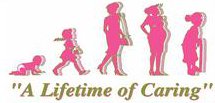
Northeastern OB-GYN Logo
Vicky started out attending Northeastern OB-GYN in Elizabeth City North Carolina, which was very good at the prenatal care they provided her. In addition to having a very nifty logo (the above is the largest I could find it online), they also gave us our first look at Sagan through ultrasound. The eggsack in the below photo is actually a vestigial trait from when our ancestors developed in an egg with a yolk.

Sagan Ultrasound 14 Weeks into Pregnancy
After moving to Norther Virginia, we first tried attending About Women OBGYN at Potomack Hospital website makes it sound like they have midwives on staff, which they don’t. We learned that it’s a standard practice in prenatal care to rotate the doctors so that every patient gets to meet every doctor so that when it’s time to deliver the patient isn’t stuck with a complete stranger. The only problem with this clinic was that there was no transfer of knowledge. We had to start from scratch with every doctor we met and there was much confusion about where Vicky was in her pregnancy. As a result, appointments for tests were miss-scheduled and prescriptions were mismanaged.
This experience of being on some sort of poorly-managed pregnancy assembly line prompted us to seriously look into midwife-assisted delivery. Usually this means home birthing; however, four dogs, three cats, and four other residents in the house made this option impractical. So we looked into birth centers staffed with midwives.
An question that comes up with delivering outside of a hospital setting is how safe is it? Studies demonstrate home birthing is as safe as hospital birthing, and studies suggesting otherwise tend to be deeply flawed (see also here). I surmise that these equivalent safety numbers have a lot to do with the fact that midwives and birth centers won’t accept high-risk pregnancies and rely on hospitals as a backup option for when labor does not progress.
In our search for certified midwives, we tried out Birth by Design, who was opening a new birth center in Fairfax Virginia. While the midwives there were very nice, there were some things that didn’t grok with me. They were very focused on herbal remedies and said that Vicky would have to agree to drinking an herbal tea every day for a healthy pregnancy. This seemed a little too New Age-y for me and I was further troubled when they said they had herbal solutions to breach pregnancies and other complications.
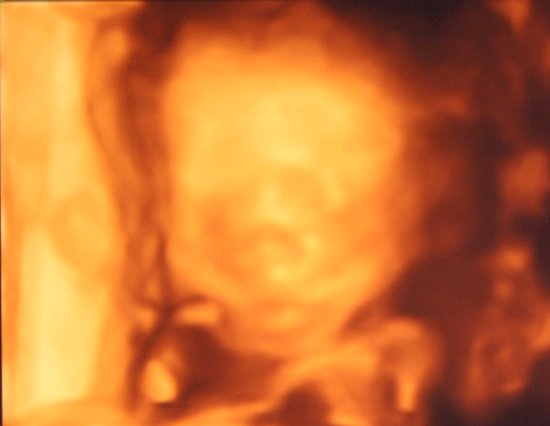
Sagan Ultrasound 20 Weeks into Pregnancy
Luckily, that same week we got taken off the waiting list for Birth Care in Alexandria Virginia. The midwives at this birthing center were very professional and clinical in their approach to labor and delivery. Their prenatal care was conditional on the patient taking responsibility for their health with prenatal vitamins, filling out their own chart for blood pressure and weight, setting up pediatric visits, proper diet, and, most importantly, taking birth classes to prepare for the experience.
Dr. Bradley believed there were instinctual behaviors animals were engaging to manage the pain and stress of childbirth. Looking to the animal kingdom for how other mammals handle labor we find the mother needs darkness, solitude, quiet, physical comfort and relaxation, controlled breathing, closed eyes, and the appearance of sleep. Our tour of Birth Care revealed an environment catered to providing such an environment, with a homey feel to the place, real beds, baths, and other comforts to allow the laboring mother to relax her body let her uterus do what it needs to do.
The Big Day: Labor and Delivery
(Note: Vicky has posted here birth story here, which is much more detailed than my abbreviated description. I highly recommend it for the detailed version of our birth story and how she prepared for labor.)
The Bradley Method classes were the most important thing we did to prepare for the big day, and that’s taking into consideration the fact that we only got halfway through them since Vicky’s water broke a month early and on July 12, 2011 Sagan Charles Somma was born at 4 pounds 13 ounces. The timing put him two days too early for us to go to the Birth Care Center, and we transferred to Alexandria Inova Hospital, a hospital we had never attended with doctors and nurses we had never met and had never discussed our desires for a natural, unmedicated birth.
We lucked out, however, as the staff was fantastic. Dr. Kenneth Adhoot observed that my wife was progressing through labor well and was admirably willing to step back and allow nature to take its course under the guidance of your nursing staff and midwife. Midwife Donna Greenfield was very professional and attended the actual delivery of our son, taking measures to avoid an episiotomy. Our nurse Heidi was a huge help, offering suggestions and coaching Vicky through her pushing.
We lucked out in another way in that just the night before we had gone shopping for all the supplies we would need for labor; unfortunately, I failed at the “Don’t let the gas tank go below 1/2 mark the last two months” bullet point and had to stop for gas on the way to the Birth Center, which Vicky was much less than thrilled about. Once at the hospital, our Birth Classes were invaluable in understanding all the procedures and anticipating the sequence of events, like when Vicky went into the Transistion Phase of labor and began doubting herself and her ability to go through a natural birth, but this passed within minutes and she focused to get through Active Labor like a champ.
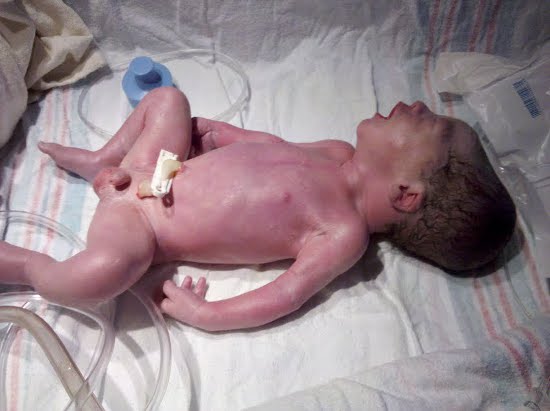
Sagan Newborn
Despite being premature, Sagan was very healthy. He had a perfectly normal problem with his blood sugar dropping, and we got that rising within 24 hours by feeding him colostrum with a teaspoon. He had problems with jaundice for the first few days because Vicky is an A-Negative blood type and I am O Positive, which prompted Vicky’s immune system to attack Sagan’s red blood cells, but this cleared up quickly by putting him in sunlight and Vicky diligently forcing him to eat and flush out the bilirubin from his system. The only minor problem we had at the hospital during our two day stay there was in keeping Sagan’s body temperature up, which the nurses blamed on our inability to keep him properly swaddled; however, I quickly solved the problem by having the hospital turn off the air conditioning to our room, after which the nurses switched to complaining about how hot it was every time they came in. I owe it to the Birth Care midwives and their policy of keeping their center air conditioned during labor, but unairconditioned afterwards to keep the baby warm and healthy for knowing to ask for this.
Our Parenting Choices
Here’s a grab-bag of notes on some of our early parenting choices:
Breast Feeding: There are myriad health advantages to breast feeding over the health problems caused by formula feeding. We intend to breastfeed exclusively for the first six months and continue the practice for a full year. This sparked some controversy as a family member argued that breast feeding will prevent our conceiving another child until Sagan is weaned and we are nearing our 40s, where we start to move into high-risk pregnancy territory. Our ancestors breastfed exclusively for two years and continued to breastfeed for up to four years. This not only had the benefit of providing excellent nutrition to the child, but also prevented the mother from conceiving until the current child was sufficiently developed. There is also the monetary savings to consider, and Vicky demonstrates on her blog, the Medela breast pump has given us an exceptional return on our investment over the cost of formula feeding.
Immunizations: We have been and continue to get Sagan any and all immunizations suggested to us. Children who aren’t immunized result in hotspot breakouts of measles, pertussis (whooping cough), polio, and diphtheria. If you are considering postponing or foregoing vaccinations, please think about Benjamin Franklin’s personal lament about not vaccinating his son against smallpox:
In 1736 I lost one of my sons, a fine boy of four years old, by the small-pox, taken in the common way. I long regretted bitterly, and still regret that I had not given it to him by inoculation. This I mention for the sake of parents who omit that operation, on the supposition that they should never forgive themselves if a child died under it; my example showing that the regret may be the same either way, and that, therefore, the safer should be chosen. [emphasis mine]
At the time of my writing this in 2011, 738 people have died since 2007 that were vaccine preventable.
Circumcision: Decided against it despite being circumcised myself. The idea that a civilization of people who thought the all the animals in the world lived within walking distance of Noah’s home had better medical science than millions of years of penis evolution through natural selection seems pretty silly. The foreskin has a bundle of sensitive nerves, it keeps the head of the penis lubricated for easier vaginal penetration (this is why we substitute spit so much in modern sex) and allows the penis to move within the shaft during intercourse as nature intended, and a very promiscuous friend once told me uncircumcised men make better lovers. Don’t mutilate your child, let them make their own decision when they get older (You can read a good factsheet on this subject here).
Co-Sleeping: We have been cosleeping with Sagan rather than having him sleep in a separate crib. It makes sense to us from an evolutionary perspective. As Mark Vonnegut puts it, “The truth is, almost all mammals (including humans) sleep with their babies. Indeed, most human babies in most cultures sleep with their parents, and always have.” The breathing reflex is stimulated not directly by the absence of oxygen but rather indirectly by the presence of carbon dioxide, so sleeping next to the baby and sharing their breathing space increases the carbon dioxide levels in the air and should reduce apnea (I don’t have research to support this however, so take it as my opinion, not science). There is also a convenience element. Baby cries, one of us rolls over to feed him, baby goes back to sleep. With breastfeeding, the mother can roll over to offer a breast and go back to sleep while the infant feeds.
This is a controversial ideal in Western cultures, and each parent needs to read up on it and make their own choice about it. The American Academy of Pediatrics will eventually release an advisory on the subject, but until then, definitely do not cosleep if you are a smoker, on medication, or have been drinking, and if you do, research how to make your bed as safe as possible.
Baby Sign Language: This will surely be the subject of a future post, but thanks to a friend of ours with a Ph.D. in Anthropology, we will be trying out Baby Sign Language as a means of communicating with Sagan before he is able to express himself verbally. I’m hoping to experience some of the same insights into how the infant understands concepts as this blogger writes about with her daughter.
What We’ve Learned at 12 Weeks
What’s surprised me most about having a baby is what an ongoing learning experience we have gotten ourselves into. Specifically, it feels like we’ve gone on an anthropology expedition, observing the ethology of the human family. We are seeing how life was like for hundreds of thousands of years for our ancestors on the Serengeti.
The first thing we’ve learned is the importance of grandparents. Evolutionists suspect that menopause in human females is actually an evolutionary adaptation because it frees the woman up to contribute care for the children of her own children; in other words, grandmother’s are a human adaptation, contributing to the care of offspring as well as contributing to the transfer of cultural knowledge. Vicky’s mother has been invaluable in caring for Sagan, happy to play with him while we use the time to get some work done. Both Vicky’s mother and my own mother have been fantastic resources on the knowledge-front as well, leading to many phone calls for questions about childcare and issues that come up, and such cultural transmission from grandmothers is why humans needed increasingly larger brains. Vicky has a great blog post up about the importance of Grandmas in helping with childcare.
Something that has taken me by surprise is the complete helplessness of the human infant. Science has demonstrated that infants are not blank slates; however, they certainly appear to be blank slates. I was blown away by how incredibly discombobulated is a newborn. They cannot focus on anything except bright lights and make no social connections with those around them until they are a few month old.
This again is the result of evolution. Humans have big brains, which make us incredibly adaptable to any environment; unfortunately, those big brains can’t fit through the birth canal without the mother’s hips being too wide to allow them to walk upright. So biology found a compromise, the infant is born with its brain only partially developed with the remainder of the development taking place outside of the womb. After a few months of oftentimes patience-straining nights up with Sagan, he started making eye-contact with us and now returns our smiles, building the social bonds that endear him to us as such behaviors endeared infants to our ancestors so that they would raise them the many years it takes to become autonomous members of the clan.
Watching baby level-up appears to have the effect of leveling us up as well.
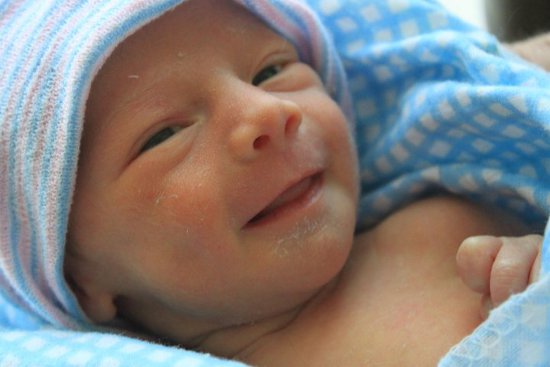
Sagan Smiling
Further Reading
You can see the Thank You letter I sent Inova Hospital here.
You can see the still-rough draft of our Birth Plan here.
I highly recommend the opening portion of This American Life’s episode Unconditional Love, which covers the history of psychology, the pre-1950s idea that affection and tenderness were bad for children, and the psychologist who proved the importance of love, who was a callous person himself.
Just this week I started reading Geek Dad’s book of suggestions for parenting with things like RPG Parenting and weekend projects with your kids. Looking forward to trying some of them out in a few years.
Update
A complete oversight, I meant to give a huge Hat Tip and Thanks to An American Expat in Deutschland for lending Vicky and I so many of the great books we read!

Comments
6 responses to “Our Childbirth Experience”